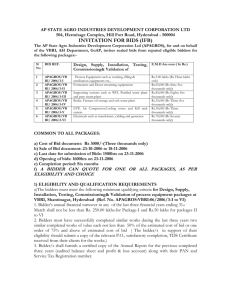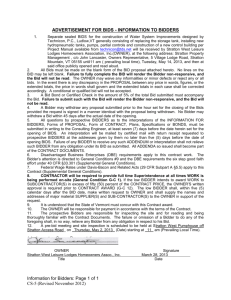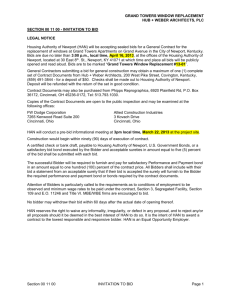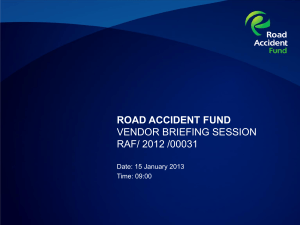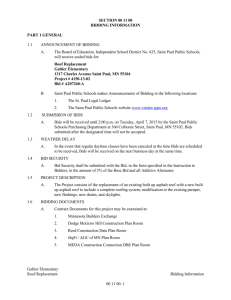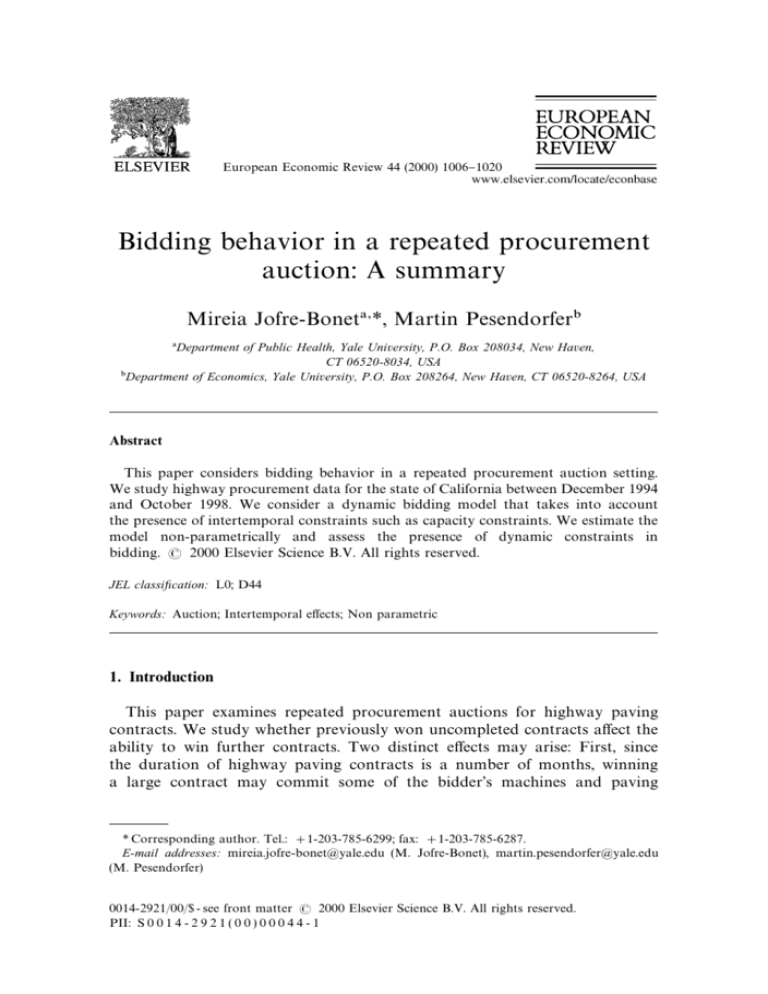
European Economic Review 44 (2000) 1006}1020
Bidding behavior in a repeated procurement
auction: A summary
Mireia Jofre-Bonet *, Martin Pesendorfer
Department of Public Health, Yale University, P.O. Box 208034, New Haven,
CT 06520-8034, USA
Department of Economics, Yale University, P.O. Box 208264, New Haven, CT 06520-8264, USA
Abstract
This paper considers bidding behavior in a repeated procurement auction setting.
We study highway procurement data for the state of California between December 1994
and October 1998. We consider a dynamic bidding model that takes into account
the presence of intertemporal constraints such as capacity constraints. We estimate the
model non-parametrically and assess the presence of dynamic constraints in
bidding. 2000 Elsevier Science B.V. All rights reserved.
JEL classixcation: L0; D44
Keywords: Auction; Intertemporal e!ects; Non parametric
1. Introduction
This paper examines repeated procurement auctions for highway paving
contracts. We study whether previously won uncompleted contracts a!ect the
ability to win further contracts. Two distinct e!ects may arise: First, since
the duration of highway paving contracts is a number of months, winning
a large contract may commit some of the bidder's machines and paving
* Corresponding author. Tel.: #1-203-785-6299; fax: #1-203-785-6287.
E-mail addresses: mireia.jofre-bonet@yale.edu (M. Jofre-Bonet), martin.pesendorfer@yale.edu
(M. Pesendorfer)
0014-2921/00/$ - see front matter 2000 Elsevier Science B.V. All rights reserved.
PII: S 0 0 1 4 - 2 9 2 1 ( 0 0 ) 0 0 0 4 4 - 1
M. Jofre-Bonet, M. Pesendorfer / European Economic Review 44 (2000) 1006}1020
1007
resources for the duration of the contract. Although rental of additional
equipment is available, this may increase total cost. Second, a learning e!ect
may arise, since supplying services on a large contract may give a bidder the
necessary expertise to conduct further services. The learning e!ect may lower the
cost for future contracts.
To examine the presence of intertemporal constraints, in Section 2, we
consider a dynamic bidding game. The model assumes that bidders learn their
costs every period anew. Costs are drawn from a distribution that depends on
the bidders state. We assume that the state is determined by the backlog from
previously won contracts. The backlog measures the amount of uncompleted
work from previously won contracts. We do not specify the nature in which the
state a!ects the distribution of costs. Instead, we let the data decide whether
there is any relationship and if so, how the state a!ects costs. In examining
equilibria of the game, we restrict our attention to Markovian strategies that
depend on payo! relevant variables. Speci"cally, we assume that bidding strategies are only a function of the level of current backlogs of "rms in the industry.
Section 3 discusses the econometric model. Paarsch (1992), La!ont et al.
(1995) and others develop an empirical approach to estimate private information in auction environments. We follow their approach and estimate private
information based on the dynamic model. We do not impose ex-ante implications of the capacity constraint on the estimation. In contrast, we examine to
what extent implications of capacity constraints are satis"ed by the data.
The empirical speci"cation follows a two-stage approach similar to Elyakime
et al. (1994) and Guerre et al. (1998). In the "rst stage, the beliefs of bidders
concerning bids of other bidders are estimated non-parametrically. Bidder
asymmetry, contract characteristics and state variables are accounted for in the
estimation. In the second stage, privately known costs are inferred using a structural relationship of the model. In our case, the structural relationship requires
an expression for the expected sum of future pro"ts. We calculate the expected
future discounted payo! of bidders numerically based on estimates of bidders'
beliefs.
Section 4 describes the data and the industry. We examine data on highway
procurement contracts in California between December 1994 and October 1998.
During this 4-year time period contracts with a total value of $5.9 billion
nominal dollar were awarded in California. For comparison, the annual value of
construction of highways, streets and related work in the US is about $35 billion
per year. Descriptive data analysis suggests the expected e!ect of backlog.
Estimates of the probability of submitting a bid reveal that bidders which
committed only a small fraction of their capacity are about twice as likely to
submit a bid than bidders who committed a large fraction.
1992 Census of Construction Industries.
1008
M. Jofre-Bonet, M. Pesendorfer / European Economic Review 44 (2000) 1006}1020
Highway construction data have been studied by a number of authors.
Feinstein et al. (1985) and Porter and Zona (1993) study issues of bidder
collusion. Bajari (1997) assesses the importance of bidder asymmetry.
Section 5 presents the estimation results of our model. In general, we "nd that
the distribution of bids exhibits the expected properties of capacity constraints.
To illustrate the estimates, we evaluate the primitives of the model at sample
characteristics of bidder 1. The bid distribution of bidder one at low backlog
values stochastically dominates (in the "rst order sense) the distribution at high
backlog values. Moreover, increasing the backlog appears to monotonically
decrease the probability of submitting a bid. Although there are some exceptions
to this rule.
The equilibrium of the model implies a monotone relationship between costs
and bids. As suggested by Elyakime et al. (1994), a test of the adequacy of the
bidding model can be based on the monotonicity property. We "nd that there is
indeed a monotone relationship between bids and costs, thus, the assumption of
the imposed bidding model is con"rmed.
Estimates of the expected future sum of pro"ts are hardly a!ected by changes
in the state. In particular, the e!ect of current backlog of the bidder on future
pro"tability appears minor. This result may not be surprising since the duration
of highway contracts is a number of months on average and e!ects on future
pro"tability should be small.
Finally, Section 6 summarizes the main conclusions of the paper.
2. The bidding model
The bidding model has the following features: There are an in"nite number of
periods, t3+0, 1,2,R,. In every period the buyer o!ers a single contract for
sale. There are two types of bidders: regular and fringe bidders. Fringe bidders
have a short life and exit in the period they entered. Regular bidders stay in the
game forever. The set of regular bidders is denoted by +1,2, n , and the set of
fringe bidders is denoted by +n #1,2, n,.
Each period bidder i learns her cost for the contract. The cost is privately
known and denoted by cR . The priors of all bidders about the cost of a regular
G
bidder cR are identical and represented by the distribution function F(c " sR , sR )
G
G where sR is a variable that summarizes the available capacity of bidder i at time
G
period t and sR denotes contract characteristics. We assume that contract
characteristics are drawn identically and independently from the distribution of
In the data we observe a number of bidders that submit a bid only once, or a small number of
times. On the other hand, we observe a number of bidders that submit bids frequently. To account
for this di!erence, we classify the largest 30 "rms in $ value won as regular bidders and the remaining
"rms as fringe bidders.
M. Jofre-Bonet, M. Pesendorfer / European Economic Review 44 (2000) 1006}1020
1009
contracts. The distribution of costs has a continuous density function f (c " sR , sR )
G and support [0, C]. Similarly, the cost of a fringe bidder is drawn from a continuous distribution function F(c " sR ) with associated density function f (c " sR ) and
support [0, C ]. The bidders may submit a bid for each contract which is the
$
price at which they are willing to provide the service. The bidder with the lowest
bid wins the contract and receives his bid. All agents are risk neutral. Ties are
resolved by the #ip of a coin. The buyer imposes a "xed (non-random) reserve
price R, meaning that bids above R are rejected. We assume that R"C .
$
The state variable includes the backlog stemming from past won contracts
and bidder speci"c characteristics. The evolution of the state depends on
the current backlog and the size of the project won this period. We
introduce a common discount factor parameter, b3(0, 1), that measures "rms'
patience with regard to future pro"ts.
We consider subgame perfect equilibria and restrict attention to Markovian
strategies. A strategy for bidder i is a function of the state vector s and bidder i's
cost at time period t. The strategy can be written as b(cR , s , s , s ) where
G G \G s denotes the vector of the states of the remaining regular bidders (s ,2, s ,
\G
G\
s ,2, s ).
G>
L
The expected future payo! for regular bidder i can be written as
< (s , s , s )" max+[b!c]Prob(i wins " b, s)
G G \G @
L
#b Prob( j wins " b, s)EQY <G (s " s, j wins), f (c " sG , s ) dc,
H
where the expectation operator, E , accounts for uncertainty with respect to
QY
contract characteristics. The payo! equals the ex ante expected current period
return plus the sum of discounted future returns. For a fringe bidder the ex ante
payo! equals to
max+[b!c]Prob(i wins " b, s), f (c " s ) dc.
@
In subsequent sections we use the following notation: We denote the distribution function of equilibrium bids of bidder i by G(b " s , s , s ) and the associated
G \G density function by g(b " s , s , s ). The probability that a bid b wins the contract
G \G for bidder i can be written as [1!G(b " s , s , s )].
H$G
H \H 3. Econometric model
In this section, we describe our econometric model. First, we argue about the
choice of state variables. Second, we describe the estimation of the bid distribution function, G, which represents bidders' beliefs. Finally, we explain how we
use G to infer costs and the distribution function of costs, F.
In order to simplify the notation, from now on we drop superscript t.
1010
M. Jofre-Bonet, M. Pesendorfer / European Economic Review 44 (2000) 1006}1020
3.1. State variables
Bidders select their bids after observing a number of variables: These include
the bidders' state variables, contract characteristics and private information. We
assume that capacities and contract characteristics are observable to all bidders
and the econometrician prior to the bidding. Private information is not observable to bidders.
Non-parametric methods impose limitations on the dimensionality of estimators. We make a number of choices concerning the variables of interest
which are in part aimed at reducing the dimension of the state space.
First, we project the logarithm of bids on a vector of contract characteristics
and we estimate the density and distribution of the resulting residuals, b.
Second, we estimate the bid distribution function using the following "ve
variables: (a , a , r, x , = ). The variable a denotes the backlog of bidder i, i.e.,
G \G
G G
G
the work amount measured in dollars that is left from previously won projects.
The backlog variable is constructed in the following way: For every contract
previously won, we calculate the amount that is left to do by taking the initial
size of the contract and multiplying it by the fraction of time that is left until the
completion time. For contracts that "nished prior to the end of the sample
period, we use the actual completion date, while for contracts that did not "nish
by the end of the sample period, we use the planned completion date. Based on
this calculation, we determine at any given point in time the total amount of
work measured in dollars that is left to do. Finally, we standardize the variable,
by applying the normal distribution to every observation. The parameters of the
normal distribution are the bidder speci"c mean (calcultated using daily obvservations) and the bidder speci"c variance. The resulting backlog variable is
a number between zero and one. Due to the standardization, the backlog
variable is comparable across bidders.
The variables r and x are indices that capture the bidders' capacity and
G
location characteristics: r(¸ , ¸ ,2, ¸ ), measures the number of bidders that
R L
are located in close proximity to the contract location, ¸ ; x (MB , ¸ , ¸ , E ) is
R G
G G R R
constructed as a linear projection of the decision to submit a bid on the space of
the maximum capacity of the "rm, MB , its location, ¸ , with respect to the
G
G
contract location, ¸ , and the engineer's estimate, E .
R
R
The variable = measures the number of contracts won by bidder i prior to
G
the sample period. It is determined based on data on contract performance
between December 1994 and April 1996 which is prior to the sample period.
The limitations for "xed sample sizes are discussed in Silverman (1986) and Simono! (1996).
We experimented with di!erent speci"cations of the backlog e!ects. In particular, we also used
a variable that measures the fraction of the maximum capacity at any point in time. The estimation
results were very similar.
M. Jofre-Bonet, M. Pesendorfer / European Economic Review 44 (2000) 1006}1020
1011
The theoretical model implies that the state of the remaining bidders have
a symmetric e!ect on bidder i's bid distribution and value function. I.e., bidder
i's bid distribution function remains unchanged if the state of bidders j and l are
exchanged. We maintain the exchangeability property with respect to the backlog
variable, a . Exchangeability implies that the exact order of the components of
\G
this vector does not matter and we can select a particular ordering. We order
elements according to their size. We report estimates using the largest di!erence
between individual order statistics, a
and a , i"1,2, n!1. We use this
\G
\G
measure, i.e. d(a , a )"sup +"a !a ",, to asses whether two vectors
\G \G
H$G H
H
a and a are close.
\G
\G
3.2. Bidder's beliefs
We estimate the density and distribution function of bids using Kernel
estimators. Bids by bidder i are observed only if b4R. To account for the
truncation, we estimate the conditional bid density g(b " b4R; a , a , r, x , = ),
G \G
G
G
and the truncation probability C(b4R " a , a , r, x , = ). Thus the density funcG \G
G
G
tion of bids is given by
g(b " a , a , r, x , = )
G \G
G
G
"g(b " b4R; a , a , r, x , = ) ) C(b4R " a , a , r, x , = ).
G \G
G
G
G \G
G
G
The theoretical model assumes that bidders observe a reserve price. Thus, bids
are drawn from a distribution with bounded support. This poses a problem in
the estimation, since Kernel estimators perform poorly close to the boundary.
To address this boundary problem, we adopt the mirror image method proposed by Schuster (1985). The method involves creating additional data points
by adding a mirror image of the data on the other side of the bound. Schuster
establishes asymptotic properties of this method.
The data do not include the reserve price, or upper bound of the support of
bids. We estimate the upper bound, or reserve price, using the maximum of the
winning bids. bM "max bR , where bR denotes the winning bid on contract t.
R 3.3. Inference of costs
Optimal bids are chosen based on the privately known cost, the beliefs about
other bidder's bids and the e!ect of all these factors on future payo!s. The
necessary "rst-order condition for equilibrium bids summarizes this relationship. The equation can be rearranged to express the cost as an explicit function
Winning bids are selected because we are certain that these bids are below the reserve price.
Non-winning bids may have been inadvertently above the reserve price.
1012
M. Jofre-Bonet, M. Pesendorfer / European Economic Review 44 (2000) 1006}1020
of the equilibrium bids, the beliefs about other bids and the value function. This
approach has been proposed by Elyakime et al. (1994) in the context of a static
auction models.
Let (.) denote the unobserved cost associated with a bid by bidder i. It is
a function of the bid, b and the state, s. Let q(b " s)"g(b " s)/(1!G(b " s)) denote
the hazard function of bids. The "rst-order condition for optimal bids yields the
following equation for privately known costs, :
(b, s , s , s )
G \G 1!b q(b " s , s , s )E [< (s " s, i wins)!< (s " s, j wins)]
H$G
H \H QY G
G
"b!
.
q(b " s , s , s )
H \H H$G
The function (b, s , s , s ) provides an explicit expression of privately known
G \G costs that involves the hazard function of bids, q, and the value function, < . It
G
states that the cost equals the bid minus a mark-down. The mark-down
accounts for the level of competition and the incremental e!ect on the future
discounted pro"t if the "rm wins the contract instead of another "rm. In order
to infer costs, we have to "nd estimators for the hazard and distribution of bids
and the value function. As explained below, an estimator of the hazard and
distribution function can be directly obtained from the data. On the other hand,
we can express the value function as a recursive expression of the distribution of
equilibrium bids. Thus, once estimates of bid distributions are obtained, we can
calculate the value function numerically.
There are a number of methods to estimate the model. We chose a nonparametric approach since we do not have any prior knowledge about the shape
of bidder's beliefs. Before explaining the estimators, we brie#y summarize in the
next section the variables used in the estimation. Then, we describe our
modeling choices.
4. The data and industry
In this section, we present our data and describe the awarding process for
contracts. In addition, we report summary statistics and descriptive analysis of
the data.
Our data consist of all California Department of Transportation (Caltrans)
contract awards for highway and street construction made between December
1994 and October 1998. Information on bids is available from from May 1,
Judd (1998) discusses numerical approximation methods.
We obtained our data from the Bid Results "les available at the Bid Summary FTP Site of the
California Department of Transportation O$ce Engineer internet site: http://tresc.dot.ca.gov/of"ce/engineer.
M. Jofre-Bonet, M. Pesendorfer / European Economic Review 44 (2000) 1006}1020
1013
1996 through October 30, 1998. During the latter period, Caltrans advertised
2083 projects from which 1850 were "nally awarded and 233 cancelled or
postponed.
The bid data contain the following information on every project awarded: Bid
opening date; Contract number; Location; Number of Working Days and the
Engineers' Estimate. Additionally, the data provides the Name, the Address, the
Amount of the Bid and the Rank of the Bid for each of the bidding "rms. In
order to obtain a measure of past performance, we complement the bid data
with the Caltrans Contract Awards database. This source contains information
on contracts awarded between December 1994 to October 1998. It provides the
dollar amount of the contract, the name and phone number of the contractor,
the location and the completion time of the work.
Contracts are awarded by the California Department of Transportation
subject to Federal Acquisition Regulations and, therefore, is very similar to
other states' procedures. The process can be described in three steps: First, the
Caltrans' Headquarters O$ce Engineer announces a project that is going to be
let and the invitation to submit bids starts. This period is called the Advertising
period and ranges between 4 and 10 weeks, depending on the size or complexity
of the project. Occasionally, the Advertising period will be reduced to expedite
project scheduling. Second, potential bidders may collect bid proposals that
explain the plans and speci"cations of the work required. Based on the
proposal bidders may submit a sealed bid. For each bid, Caltrans checks that
the bidding "rm is among the "rms that are quali"ed to do business with
Caltrans. Third, on the letting day, the bids are unsealed and ranked. The
project is awarded to the lowest bidder provided that the required responsibility
criteria are full"lled. After each letting, a list of all bids and their rankings is
announced and made accessible to the public.
Between May 1st of 1996 and October 30th of 1998, the Caltrans awarded
1850 contracts. The total value of the contracts was $3834.35 million. A total of
9679 bids were received for these projects. According to Table 1, on average
See the Project Submission and Estimate Guide at the Caltrans O$ce Engineer site, the Federal
Acquisition Regulations and the Transport Acquisition Manual at the Department of Transportation Site.
See Porter and Zona (1993) for a detailed explanation of New York State Department of
Transportation, for instance.
Project's characteristics, terms and identi"cation number.
Prior to the bidding, potential bidders have to qualify for contractual work for the Department
of Transportation and are required deposit a predetermined amount of funds that have to be
available. Violation of the contract speci"cations and delivery scheduling can cause the rejection of
a submitted bid.
The winning bid is compared to the Caltrans engineers' estimate. The bid is accepted if all
computations and cost imputations are considered correct. The winning "rm is awarded the project
no more than 30 days after the letting date.
1014
M. Jofre-Bonet, M. Pesendorfer / European Economic Review 44 (2000) 1006}1020
Table 1
Descriptive statistics of selected variables
Number of bids per contract
Backlog
Distance to the project
Estimate
(Ranked 1 } Estimate)/
Estimate
(Ranked 2 } Ranked 1)/
Ranked 1
Number of
observations
Mean
Standard
deviation
Minimum
Maximum
1850
55 770
55 770
1850
1850
4.96
0.32
226
13.39
!0.03
2.15
0.29
11 071
1.35
0.23
1.00
0.00
0
9.47
!0.79
9.00
1.00
722 335
18.31
1.34
1800
0.10
0.18
0.00
5.08
Backlog measures the amount of uncompleted work from previously won contracts.
Logarithm of the estimate.
Ranked 1 and Ranked 2 are the winning bid and the bid ranked in second position, respectively.
Table 2
Probit estimates of the bid submission decision
Number of observations
s
Degrees of freedom
Pseudo R
Log likelihood
<ariable
Reserve price
Estimate
Working days
Nbid-fringe
Distance
Number of wins
Number of wins in the region
Backlog
Backlog within the region
Constant
68913
3017.24
9
0.124
!10977.93
!0.1913
(0.042)
0.3819
(0.040)
!0.1631
(0.011)
!0.0514
(0.017)
!0.1698
(0.013)
0.0148
(0.001)
0.1806
(0.005)
!0.0824
(0.009)
0.0448
(0.014)
!3.3298
(0.114)
68913
2952.74
7
0.121
!11013.33
68913
699.81
4
0.025
!12213.92
!0.1966
(0.042)
0.3864
(0.040)
!0.1649
(0.011)
!0.0504
(0.017)
!0.1694
(0.013)
0.0148
(0.001)
0.1793
(0.005)
!0.2088
(0.040)
0.3726
(0.038)
!0.1256
(0.010)
!0.0465
(0.016)
!3.3065
(0.114)
!3.2593
(1.021)
Reserve price, estimate, working days are in logarithm. The numbers in parentheses are robust
standard deviations.
M. Jofre-Bonet, M. Pesendorfer / European Economic Review 44 (2000) 1006}1020
1015
there were 5.23 bidders per contract, ranging from 1 to 24 bidders across
projects. A total of 50 projects received one bid, 191 contracts received two, 288
contracts received three bidders and so on.
Table 2 reports the probit estimates of the decision to submit a bid. Explanatory variables include contract speci"c characteristics such as the estimate and
the number of working days, and, bidder speci"c characteristics such as the
bidder's maximum capacity, the distance of the bidder's closest plant to the
project location. On average, a constrained bidder is 50% less likely to submit
a bid than an unconstrained bidder. Distance to the project decreases the
probability to submit a bid at an increasing rate. As the size, or estimate, of the
project increases the probability of submitting a bid intially decreases and then
increases at an increasing rate. The number of working days of the project have
a negative e!ect.
5. Estimation results
This section describes the estimation results of the bidding model. First,
we report estimates of the bid distribution. Second, we describe estimates of
the value function. Third, we consider the condition of identi"cation. Finally, we
report cost estimates for one bidder.
The "rst problem when estimating the model is to choose a suitable bandwidth. On the one hand, the bandwidth must be large enough to produce
a smooth curve, while on the other hand being small enough not too produce to
much bias. In the calculations, we select the bandwidth using the ocular method.
Fig. 1 plots the estimates of the distribution of bids. Estimates are reported for
backlog equalling 0.1, 0.05 and 0.9. Other state variables are "xed at their
sample average values. From the "gure, we see that an average regular bidder
submits a bid on between 2 and 5% of all contracts. The participation in an
auction is more likely with low backlog levels.
The stochastic dominance property of the distribution functions for di!erent
backlog levels in Fig. 1 is evident. Fig. 1 illustrates this property for "xed levels
of the backlog variable.
Fig. 2 plots the estimates of the probability of submitting a bid as a function of
the backlog and holding other variables constant at their sample average. The
"gure suggests that the probability of submitting a bid declines monotonically in
backlog: When backlog equals 0, the probability equals 6%; it falls to 5% as
backlog increases to 0.5; and when backlog exceeds 0.7 the probability of
submitting a bid declines to 2%. Although the relationship is monotone at
sample average values, there are instances where the relationship is not monotone.
Fig. 3 depicts estimates of the value function evaluated as a function of
the backlog and holding other variables constant at the sample average state
1016
M. Jofre-Bonet, M. Pesendorfer / European Economic Review 44 (2000) 1006}1020
Fig. 1. Bid distribution at average values.
Fig. 2. Probability of submitting a bid as a function of a .
G
M. Jofre-Bonet, M. Pesendorfer / European Economic Review 44 (2000) 1006}1020
1017
variables for bidder 1. The plus signs indicate con"dence intervals at the
approximation points of the value function. The con"dence intervals account for
the approximation error due to the numeric calculation of the value function.
The value function is calculated assuming a 0.95 annual discount factor which
corresponds to a 5% interest rate.
Fig. 3 indicates that the value function is almost #at over the range of the
backlog variable. Thus, there is little e!ect of winning a large contract today on
the future discounted pro"tability of the "rm. A reason may be that with
a discount factor of about 0.95, the duration of highway paving contracts is too
short to have an e!ect on the long run pro"tability of the "rm. In the most
extreme case, in which a contract commits all resources for one year, we would
expect at most an e!ect of 5% on the value function. Thus, the magnitude of this
e!ect may be too small to a!ect future pro"ts.
Inference of unknown costs from observed bids is based on a monotone
relationship between the inverse bidding function and the cost. Next, we examine whether this assumption is satis"ed in the data. Fig. 4 depicts the relationship between bids and estimated costs for bidder 1. For comparison the "gure
also plots the 453 line. Fig. 4 shows that there is a monotone relationship. Thus,
for bidder 1, the inference is valid.
Based on Fig. 4, it is di$cult to assess whether the di!erence between bids and
costs is decreasing or increasing as bids increase. An examination of the relative
Fig. 3. Value function for bidder 1.
1018
M. Jofre-Bonet, M. Pesendorfer / European Economic Review 44 (2000) 1006}1020
Fig. 4. Bid function at average values for bidder 1.
Fig. 5. Distribution of costs at average values for bidder 1.
M. Jofre-Bonet, M. Pesendorfer / European Economic Review 44 (2000) 1006}1020
1019
mark-up of bidder 1 which is de"ned as the bid minus the cost divided by the bid
reveals that the mark-up is declining in costs.
Fig. 5 illustrates the distribution of costs for bidder 1. Estimates are reported
for backlog equaling 0.1 and 0.9. Other variables are "xed at sample average
values. The cost distribution exhibits the stochastic dominance property.
The average cost is lower with a low than with a high level of backlog.
This suggests that capacity constraint play an important role in highway
procurement contracts.
6. Conclusion
This paper presents a structural model of intertemporal e!ects in bidding. We
estimate the model and "nd that the data con"rm the intuition: Bidding
behavior is a!ected by capacity constraints. Bidders with a high backlog have
on average a higher cost than bidders with a low backlog.
Further research will quantify the ine$ciency of the "rst price auction rule
induced by the asymmetry stemming from backlog. In addition, we intend to
evaluate alternative auction rules, such as second price auctions and/or di!erent
bid opening time pro"les in terms of e$ciency and cost for the department of
transportation.
Acknowledgements
We wish to thank seminar audiences at Wharton and at the Hebrew University for helpful comments. Kenneth Chan and Nancy Epling provided excellent
research assistance. Also, we are grateful to the California Department of
Transportation for its invaluable help.
References
Bajari, P., 1997. Econometrics of the "rst price auction with asymmetric bidders. Mimeo., Stanford.
Elyakime, B., La!ont, J.J., Loisel, P., Vuong, Q., 1994. First-price sealed-bid auctions with secret
reservation prices. Annales d'Economie et de Statistique 34, 115}141.
Feinstein, J.S., Block, M.K., Nold, F.C., 1985. Asymmetric information and collusive behavior in
auction markets. American Economic Review 75 (3), 441}460.
Guerre, E., Perrigne, I., Vuong, Q., 1998. Optimal nonparametric estimation of "rst-price auctions,
Mimeo., University of Southern California, Los Angeles, March.
Judd, K., 1998. Numerical Methods in Economics. MIT Press, Cambridge, MA.
La!ont, J.-J., Ossard, H., Vuong, Q., 1995. Econometrics of "rst-price acutions. Econometrica
63.
Paarsch, H., 1992. Deciding between the common and private value paradigms in empirical models
of auctions. Journal of Econometrics 51, 191}215.
1020
M. Jofre-Bonet, M. Pesendorfer / European Economic Review 44 (2000) 1006}1020
Porter, R.H., Zona, J.D., 1993. Detection of bid rigging in procurement auctions. Journal of Political
Economy 101, 518}538.
Schuster, E.F., 1985. Incorporating support constraints into nonparametric estimators of densities.
Communications Statistics } Theory and Methods 14 (5), 1123}1136.
Silverman, B.W., 1986. Density Estimation for Statistics and Data Analysis. Chapman & Hall,
London.
Simono!, J.S., 1996. Smoothing Methods in Statistics. Springer, Berlin.

